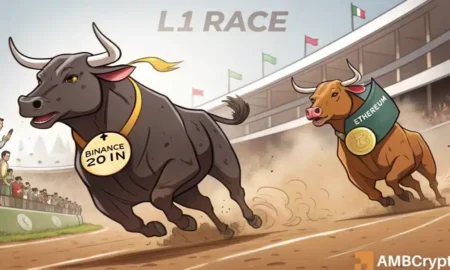Bitcoin Whale Inflows Surge Amid Valuation Conflicts: Is a Breakout Imminent?
Bitcoin (BTC) has recently shown a notable increase in whale inflows, surging by 26% this week. This surge has sparked some optimism among traders, yet long-term outflows continue to overshadow these short-term gains, dampening the potential for sustained price recovery. As BTC hovers around $95,952.36—a slight decline of 0.33%—the cryptocurrency grapples with a complex interplay of technical signals, market dynamics, and valuation metrics that could either propel it toward a new high or thwart its momentum once again.
Short-Term Optimism vs. Long-Term Stagnation
The uptick in whale accumulation has brought a glimmer of hope to market participants. In the past week, the Large Holder Netflow indicator rose by 26.41%, indicating a resurgence of large investors engaging with Bitcoin at current price levels. However, this short-term enthusiasm stands in stark contrast to the long-term trend reflected in the 30-day and 90-day Netflows, which plummeted by 108.09% and 110.13%, respectively. This discrepancy is a critical sign that, while short-term accumulation is encouraging, broader market forces may still be in play, limiting Bitcoin’s potential for a sustained upward trajectory.
High Network Activity: A Double-Edged Sword
On-chain metrics further complicate the outlook. Recent data from Glassnode shows a significant increase in on-chain activity, with 925,914 active addresses recorded within a 24-hour window—the highest level of engagement seen in six months. This surge might suggest a robust interest in the Bitcoin network; however, a deeper look reveals that enthusiasm may be overstated. According to Santiment’s Price DAA (Daily Active Addresses) Divergence, the figure stood at -225.82%, indicating that Bitcoin’s price is currently outpacing organic user growth. Such a discrepancy raises questions about the sustainability of this price action.
Conflicting Valuation Metrics
The current state of Bitcoin’s valuation presents a muddled picture. Various models suggest differing signals regarding market health. The Puell Multiple, which gauges miner revenues, sits at 1.36—indicative of a healthy revenue range. However, other metrics, such as the NVT (Network Value to Transactions) and NVM (Network Value to Market Cap) ratios, have risen by 50% and 26%, respectively, signaling that Bitcoin’s market capitalization is rising faster than both transaction activity and user engagement. Conversely, a 50% decline in the Stock-to-Flow Ratio points to a weakening sentiment around Bitcoin’s long-term scarcity pricing, creating a valuation gray zone that further complicates decision-making for traders and investors alike.
Key Price Levels to Watch
Market indicators are also drawing attention to specific price levels that could dictate Bitcoin’s next move. According to Binance’s Liquidation Heatmap, there are significant liquidity clusters around $94,000 and $98,000. These zones represent areas where leveraged positions are concentrated; thus, price volatility tends to spike when these thresholds are breached. Should Bitcoin break above $98K, it could trigger a wave of short liquidations, possibly creating a further upward spiral. Conversely, a drop below $94K could compel long positions to liquidate, pushing prices down.
The Path Ahead: Cautious Optimism Amid Uncertainty
As market conditions evolve, Bitcoin finds itself at a crossroads. The increase in network activity and fresh whale inflows may suggest that positive momentum is brewing; however, persistent long-term selling pressure, along with misalignments in key valuation metrics, makes the path to a breakout above $98K uncertain. For traders, while there are glimmers of potential growth, caution remains paramount until clearer alignment across these dynamic indicators emerges. Monitoring key price levels will be essential in determining whether Bitcoin can stabilize and create the conditions necessary for a significant breakout.
In conclusion, while the recent uptick in whale inflows and network activity rekindles hope for Bitcoin’s price recovery, the broader market context—marked by long-term outflows and conflicting valuation signals—requires a careful, nuanced approach. Traders must remain vigilant and adapt to ever-changing market dynamics to navigate this complex landscape successfully.

















